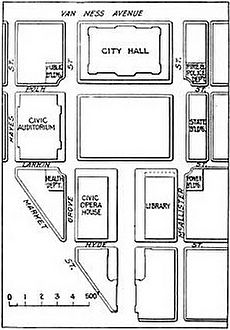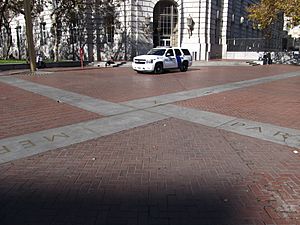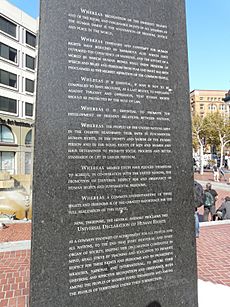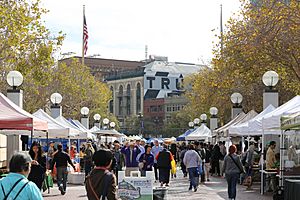United Nations Plaza (San Francisco) facts for kids
Quick facts for kids United Nations Plaza |
|
|---|---|

UN Plaza features the emblem of the United Nations and a view of San Francisco City Hall, looking west (2010)
|
|
| Lua error in Module:Location_map at line 420: attempt to index field 'wikibase' (a nil value). | |
| Location | Civic Center |
| Nearest city | San Francisco |
| Area | 2.6 acres (1.1 ha) |
| Created | 1975 |
| Designer |
|
| Public transit access | Muni Metro/BART (Civic Center) |
United Nations Plaza, often called UN Plaza, is a 2.6-acre (1.1 ha) public space in San Francisco, California. It is located in the city's Civic Center area. The plaza sits on parts of what used to be Fulton and Leavenworth Streets. It is bordered by Market, Hyde, McAllister, and 7th Street.
UN Plaza is about 1⁄4 mi (0.40 km) east of City Hall. A walkway called Fulton Mall and Civic Center Plaza connect it to City Hall. You can easily get to the plaza using public transport. The BART and Muni Metro trains stop at the Civic Center/UN Plaza station, which has an entrance right inside the plaza.
Famous architects like Lawrence Halprin, John Carl Warnecke, and Mario Ciampi designed UN Plaza. Halprin created the large sunken fountain. The plaza opened in 1975. It was built to remember the creation of the United Nations and the signing of the Charter of the United Nations in San Francisco on June 26, 1945. The plaza has been updated several times, including in 1995 and 2005. New ideas for its design were suggested in 2018.
Discovering UN Plaza's History

After the big 1906 San Francisco earthquake destroyed the old City Hall, the city rebuilt it. They also built other government buildings to create the Civic Center. The main road to the new Civic Center from Market Street was Fulton Street. This street ran between McAllister and Grove.
The new City Hall (built in 1915) and Civic Center Plaza (built in 1911) each took up two city blocks. So, the eastern part of Fulton Street started at Larkin and ended at Market. Today, the western half of Fulton (from Larkin to Hyde) is called Fulton Mall. The eastern half (from Hyde to Market) is now UN Plaza.
UN Plaza also includes a part that runs north–south. This section was built on what used to be Leavenworth Street. It continues north of McAllister. The Leavenworth and Fulton parts of UN Plaza meet at a right angle. The United Nations Plaza Fountain and the entrance to the transit station are located where these two parts meet.
How the Plaza Idea Started
The idea for a walking area with trees and paved spaces first came up in 1958. This plan aimed to extend the central park area from City Hall down Fulton Street to Market. At the same time, a new subway system was being planned along Market Street. This subway would later serve both BART and Muni Metro trains.
In 1962, landscape architect Lawrence Halprin shared his vision for the walking area. He believed that opening up views into the Civic Center would greatly benefit Market Street. The idea for this pedestrian mall was included in a 1963 city plan.
In 1965, the first sketches for the Civic Center Station Plaza were made. This plaza would be near Seventh Street. It was meant to serve the future underground train station. It would also connect to Fulton Mall and the bus terminal. In 1967, designers updated their plans for the new plaza. They wanted a "major civic sculpture" to be the main focus. This sculpture became the large fountain, designed by Halprin and finished in 1975.
In 1968, the architecture firms led by Halprin, Ciampi, and Warnecke teamed up. They formed the Market Street Joint Venture Architects. This group was in charge of the big Market Street Redevelopment Plan. UN Plaza was designed as part of this plan. The same team also designed two other large plazas along Market Street: Hallidie Plaza (1973) and Embarcadero Plaza (1972). The Market Street Redevelopment Plan was mostly finished by 1979.
Building UN Plaza
The original design of UN Plaza featured 117,000 sq ft (10,900 m2) of brick paving. It also had 20,000 sq ft (1,900 m2) of grass lawn. In the southwest part of the plaza, near Market Street, there is a cross made of granite blocks. These blocks have brass inlays that show San Francisco's coordinates. These coordinates are used to measure distances to other cities. This spot is also where the original City Hall once stood.
The walking path along the Fulton side had 16 light poles and 24 wooden benches. There were also 192 London plane and black poplar trees. The main feature was the large fountain, made of granite slabs. The design of UN Plaza is credited to Halprin & Associates. Don Carter was the main person in charge, and Angela Danadjieva was the landscape architect.
Several buildings were torn down to make space for the new plaza. Only the Orpheum Theater (1925), 1 United Nations Plaza (1932), and the Federal Building (1936) remained. UN Plaza was built from January to June 1975. This happened after Market Street was rebuilt following the subway construction.
The plaza was dedicated in 1975. This was to celebrate the creation of the United Nations. It also marked the 30th anniversary of the signing of the Charter of the United Nations on June 26, 1945. Mayor Joseph Alioto dedicated the first tree on the plaza on June 26, 1975. This tree honored the late UN Secretary-General Dag Hammarskjöld.
Plaza Updates and Changes
UN Anniversaries
In 1995, for the 50th anniversary of the United Nations, a "Walk of Great Ideas" was added. This project cost US$400,000 (equivalent to $770,000 in 2022) and was paid for by donations. The Walk included eight white granite stones. These stones had the beginning of the UN Charter written in brass. This matched the style of the coordinates cross in the plaza.
Other updates in 1995 included:
- Listing UN member nations on the light poles.
- Adding the UN emblem to the center of the plaza.
- Engraving the start of the Universal Declaration of Human Rights on a 17-foot (5.2 m) tall black granite monument.
- Updating the lights to frosted glass globes.
Another round of updates began in March 2005. This cost US$1,500,000 (equivalent to $2,200,000 in 2022) for the UN's 60th anniversary. Plans included a new stone monument for UN World Environment Day 2005. They also planned to hang the flags of all 191 member nations. New member nation names were added to the light poles. The city also started to host more events at the plaza. This was to make it a lively place for everyone to enjoy.
Civic Center Public Space Plan
In 2017, a design firm called CMG Landscape Architecture was hired. They were asked to redesign UN Plaza, Civic Center Plaza, and Fulton Mall. The goal was to keep the plaza's size but encourage more people to walk through it. In Spring 2018, CMG showed three ideas:
- Civic Sanctuary: This design aimed to celebrate history. It brought back the classic style of the original plan.
- Culture Connector: This idea focused on being welcoming to everyone. It included more trees to provide shade for a path between Market Street and City Hall.
- Public Platform: This plan was about creating flexible spaces for temporary events and performances.
What Happens at UN Plaza Today?
Rebecca Solnit, a writer for the San Francisco Chronicle, described UN Plaza in 2004. She called it a place where you feel connected to the world. She said it encourages people to march, gather, and walk. It's a public space that brings people together. It hosts a busy farmer's market and many protests near government offices.
Since 1981, the Heart-of-the-City Farmers Market has been held at UN Plaza. It takes place on Wednesdays and Sundays. This market helps provide fresh food to the Civic Center and South of Market neighborhoods.

UN Plaza has long been a gathering place for people, including those experiencing homelessness. An annual memorial, the Interfaith Homeless Persons Memorial, is held there. It takes place near the winter solstice to remember those who have died without a home that year.
UN Plaza was designed as a starting point for parades. These parades would march along Market Street to City Hall. The Gay Freedom Day Parades in 1977 and 1978 used this route. These parades were very large and helped San Francisco become known for LGBTQ+ activism. From 1985 to 1995, UN Plaza was the site of a protest called the ARC/AIDS Vigil. This was a protest against the government's slow response to a serious health crisis. Volunteers stayed in a camp at UN Plaza for ten years to support this protest.
The Famous Fountain
The fountain in UN Plaza was designed by Lawrence Halprin and Ernest Born. It was finished in 1975. The granite slabs in the fountain are meant to look like the continents of Earth. The lowest central block represents a mythical lost continent. The original design intended for water to fill and drain from the basin. This would happen on a two-minute cycle, like ocean tides. Jets of water were supposed to make the fountain visible from the street. They would also signal the start of a new water cycle. The fountain was designed to adjust to wind. This would prevent water from splashing people walking by. However, the fountain never worked exactly as planned. It was fenced off as early as 1978.
The fountain cost US$1,200,000 (equivalent to $6,530,000 in 2022) to build. It is mostly sunken into the brick plaza. Its basin is 100 feet (30 m) wide. It contains 673 granite blocks and is 165 feet (50 m) long. Some blocks have words carved into them, including a quote from Franklin Delano Roosevelt. Halprin said the fountain was meant to be a place for people to walk, sit, and even perform. He wanted to create a space that people could truly use.
Fountain Issues and Future Plans
In 1994, there was a suggestion to remove the fountain. It had become a gathering spot for many people. It also had issues with cleanliness. Some called it "too big," but Halprin disagreed. Because the fountain is part of the city's art collection, removing it would require many official reviews. A report in 1995 found that the fountain was not working as designed. Only one pump was still working, and the water filter was broken.
In March 2003, the city fenced off the fountain and turned off its water. This was to help with cleaning. That same month, a group suggested removing the fountain. However, the city's leaders decided not to remove it.
Poles and chains were added around the fountain in 2005 to keep people out. These have since been removed. A metal fence was put up around the fountain again in 2018. This was replaced by a white plastic fence in 2019. Later, a tall plywood fence was put up. This was to prepare for a project to turn part of the fountain into a 15,000 US gal (57,000 L) storage tank. This tank would hold treated water for washing streets in the Civic Center area.
In 2018, three ideas were proposed to redesign the entire Civic Center area, including UN Plaza. Only one of these, Civic Sanctuary, suggested restoring the fountain. Public Platform proposed a new "interactive fountain" near the current site. Culture Connector suggested removing the water features entirely. It would turn the fountain into a climbing playground. This led to protests from some groups who wanted to save the fountain. Many people did not support keeping the fountain. A 2011 survey found it was one of the least favorite public art pieces in San Francisco.
In February 2019, a new idea was proposed. It suggested turning the fountain into an "interactive fountain and garden." This would involve partly filling it and adding plants. While some welcomed keeping the fountain, there was doubt about when the plan would actually happen.
How People See UN Plaza
When the fountain was first revealed, some critics did not like it. However, Andrew Young, the United States Ambassador to the United Nations, called it a "tribute to the U.N.'s goals." In 2007, another critic said that Halprin's plazas along Market Street "haven't aged well."
Important Status
When the Civic Center was nominated for the National Register of Historic Places, UN Plaza was noted. It was seen as providing a clear path for people to walk from Market Street to City Hall. UN Plaza is considered important enough to be on the National Register of Historic Places on its own. San Francisco also believes it should be on the California Register of Historic Resources. This is because of its original design and its historical role in the LGBTQ+ movement, as a site for parades and protests.
|





